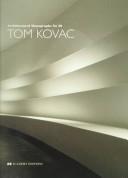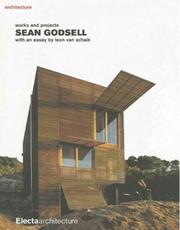| Listing 1 - 10 of 18 | << page >> |
Sort by
|
Book
ISBN: 9780470723234 0470723238 047072322X 9780470723227 Year: 2008 Publisher: Chichester: Wiley,
Abstract | Keywords | Export | Availability | Bookmark
 Loading...
Loading...Choose an application
- Reference Manager
- EndNote
- RefWorks (Direct export to RefWorks)
Le livre est organisé en trois parties distinctes qui montrent la signification de l'intelligence spatiale pour l'architecture : la première partie fournit une vue d'ensemble de l'intelligence spatiale comme capacité humaine ; la deuxième partie présente comment la reconnaissance de cette capacité dans l'éducation architecturale et dans la profession devrait permettre la démystification de la pratique de conception, formant la base d'une relation plus démocratique entre société et pratique architecturale ; la dernière partie explore les nouvelles possibilités offertes pour la pratique grâce à l'utilisation conjointe des environnements réels et virtuels. "Providing an overview of spatial intelligence as a human capability, this book also acknowledges how widespread recognition of it in architectural education and the profession should enable the demystification of the practice of design, forming the basis of a more democratic interface between society and practice. Ultimately, it suggests how spatial intelligence might provide exciting new opportunities for practice in the linking of real and virtual environments in the information age."--Jacket.
architectuur --- architectuurtheorie --- openbare ruimte --- Architecture --- Space (Architecture) --- Espace (Architecture) --- Space perception. --- Perception spatiale --- Architectural design. --- Design architectural --- 72.01 --- Architectuurtheorie ; ruimtelijke intelligentie --- 72.017 --- 711.4 --- 159.93 --- Architectuur ; theorie, filosofie, esthetica --- Architectuurtheorie --- Architectuur (theorie) --- Ruimte (architectuur) --- Stedenbouw (theorie) --- Architectuurtheorie. Bouwprincipes. Esthetica van de bouwkunst. Filosofie van de bouwkunst --- Zintuiglijke waarnemingen --- 159.93 Zintuiglijke waarnemingen --- 72.01 Architectuurtheorie. Bouwprincipes. Esthetica van de bouwkunst. Filosofie van de bouwkunst --- Space perception --- Architectural design --- Perception de l'espace --- Pratique architecturale --- Conception architecturale --- 72.01 Theory and philosophy of architecture. Principles of design, proportion, optical effect --- Theory and philosophy of architecture. Principles of design, proportion, optical effect

ISBN: 0470843241 Year: 2002 Publisher: London Wiley
Abstract | Keywords | Export | Availability | Bookmark
 Loading...
Loading...Choose an application
- Reference Manager
- EndNote
- RefWorks (Direct export to RefWorks)
Poetry --- poetry --- art [fine art] --- Architecture --- architecture [discipline] --- anno 1900-1999 --- Architectuur --- Poëzie --- kunst --- architectuur [vakgebied] --- poëzie --- Poetics --- art [discipline]

ISBN: 1904313337 Year: 2005 Publisher: Milano : Electa architecture,
Abstract | Keywords | Export | Availability | Bookmark
 Loading...
Loading...Choose an application
- Reference Manager
- EndNote
- RefWorks (Direct export to RefWorks)
Architecture --- History --- Histoire --- Godsell, Sean, --- ARCHITECTURE --- GODSELL, Sean (1960 - ....) --- AUSTRALIE --- 1990 - ....
Book
ISBN: 9780648435587 Year: 2020 Publisher: Melbourne Uro Publications
Abstract | Keywords | Export | Availability | Bookmark
 Loading...
Loading...Choose an application
- Reference Manager
- EndNote
- RefWorks (Direct export to RefWorks)
What makes a good school great? A good community of practice great? For close to half-a-century, architect and educator Leon van Schaik has prosecuted an answer to these questions. It is a venture that would lead him from the Architectural Association in London, to the townships of apartheid South Africa, and finally to Australia and the Royal Melbourne Institute of Technology (RMIT), where he initiated its now globally-renowned practice-based architecture research program.In Building a Culture, van Schaik traces the origin and development of design practice research at RMIT and his own journey into architecture and its teaching. From his early university studies under artist Richard Hamilton, to his experiences with Alvin Boyarsky at the Architectural Association, and his work alongside Cyril Ramaphosa at the Urban Foundation in South Africa, van Schaik imparts learnings garnered from a lifetime spent studying and cultivating successful creative ecologies.Through anecdotes and a consideration of archival material, the author draws a ‘loose-fit’ roadmap to implementing cultural change in educational organisations, detailing most especially the challenges he encountered developing RMIT’s unique pedagogical culture and its innovative practice-based research program.Based on a 2018 lecture van Schaik gave at RMIT on the occasion of his appointment to Emeritus Professor, Building a Culture is an insider’s account of how organisational transformation was effected within this renowned architectural school. It is also a lively and at times humorous personal reflection on the people, ideas and experiences that have shaped the thinking of one of Australia’s most influential educators.
Schools of architecture --- Architecture --- Écoles d'architecture --- Study and teaching --- Étude et enseignement --- Royal Melbourne Institute of Technology (Australia) --- Royal Melbourne Institute of Technology (Australia). --- History. --- Higher education --- architectural education --- Australia

ISBN: 0471977497 9780471977490 Year: 1998 Publisher: London: Academy editions,
Abstract | Keywords | Export | Availability | Bookmark
 Loading...
Loading...Choose an application
- Reference Manager
- EndNote
- RefWorks (Direct export to RefWorks)
Ville --- Urbanisme --- Dessin --- Dessin d'architecture

ISBN: 1904313442 9781904313441 Year: 2004 Publisher: Milan: Electa Architecture,
Abstract | Keywords | Export | Availability | Bookmark
 Loading...
Loading...Choose an application
- Reference Manager
- EndNote
- RefWorks (Direct export to RefWorks)
This monograph documents the work of the Australian architect Sean Godsell. Godsell was born in 1960 in Melbourne, where he took a degree in architecture at the University of Melbourne in 1984. The following year he traveled in Japan and Europe; then, until 1988, he worked in the studio of Denys Lasdun in London. Having returned to Australia, in 1994 he founded the studio Godsell Associates Pty Ltd Architects in Melbourne. Starting in 1994 he was a tutor at the Royal Melbourne Institute of Technology, where he took a Master's degree in Architecture in 1999. In recent years he has received many international prizes and honors. The central focus of Godsell's research is the theme of residence, approached through study of Japanese traditions and constant investigation of the questions of paths, materials and light. The fascinating nature of Australia, the age-old trees, sand dunes and luminous colors form the backdrop for the work of this young architect. The materials utilized in his buildings -such as wood, first of all- reflect these characteristics, conveying a sense of wild but composed natural vigor. Starting with the houses built in the early 1990s, such as Gandolfo House (1993-94) and MacSween House (1995), the monograph continues with certain residential works that have received many prizes, like Kew House (1996-97), Carter/Tucker House (1998-2000) and Peninsula House (2000-02). (extrait de www.electaweb.it)
Architecture contemporaine --- Bois --- Construction en bois --- Godsell, Sean --- Australie
Book
ISBN: 0864590857 9780864590855 Year: 2000 Publisher: [Australia] RMIT University
Abstract | Keywords | Export | Availability | Bookmark
 Loading...
Loading...Choose an application
- Reference Manager
- EndNote
- RefWorks (Direct export to RefWorks)
Space (Architecture) --- Architectural design --- Modernism (Art)
Book
ISBN: 0646210548 Year: 1995 Publisher: Melbourne Printed Books
Abstract | Keywords | Export | Availability | Bookmark
 Loading...
Loading...Choose an application
- Reference Manager
- EndNote
- RefWorks (Direct export to RefWorks)
Digital
ISBN: 9781118829011 Year: 2015 Publisher: London John Wiley & Sons
Abstract | Keywords | Export | Availability | Bookmark
 Loading...
Loading...Choose an application
- Reference Manager
- EndNote
- RefWorks (Direct export to RefWorks)
Architecture --- garden pavilions --- temporary structures --- public spaces --- pavilions [building subdivisions]
Book
ISBN: 0864592477 Year: 2003 Publisher: Melbourne, Vic. : RMIT University Press,
Abstract | Keywords | Export | Availability | Bookmark
 Loading...
Loading...Choose an application
- Reference Manager
- EndNote
- RefWorks (Direct export to RefWorks)
Architectural design. --- Architecture --- Design architectural --- Philosophy --- Aesthetics. --- Study and teaching --- Philosophie --- Esthétique --- Étude et enseignement
| Listing 1 - 10 of 18 | << page >> |
Sort by
|

 Search
Search Feedback
Feedback About UniCat
About UniCat  Help
Help News
News